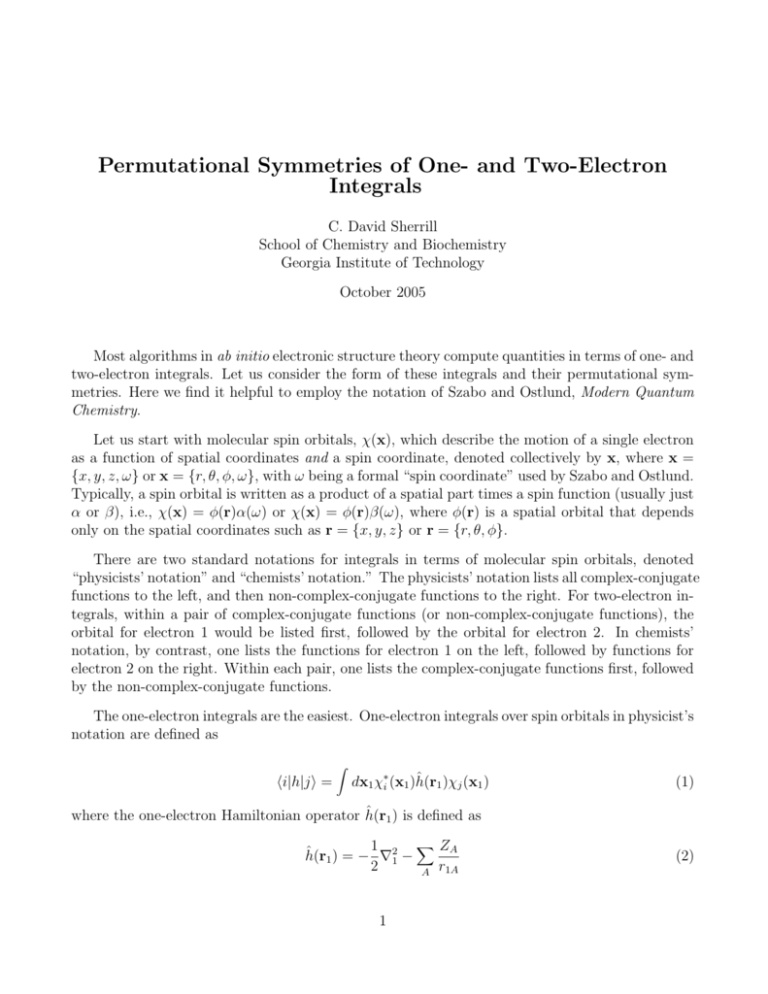Permutational Symmetries of One- and Two
advertisement

Permutational Symmetries of One- and Two-Electron
Integrals
C. David Sherrill
School of Chemistry and Biochemistry
Georgia Institute of Technology
October 2005
Most algorithms in ab initio electronic structure theory compute quantities in terms of one- and
two-electron integrals. Let us consider the form of these integrals and their permutational symmetries. Here we find it helpful to employ the notation of Szabo and Ostlund, Modern Quantum
Chemistry.
Let us start with molecular spin orbitals, χ(x), which describe the motion of a single electron
as a function of spatial coordinates and a spin coordinate, denoted collectively by x, where x =
{x, y, z, ω} or x = {r, θ, φ, ω}, with ω being a formal “spin coordinate” used by Szabo and Ostlund.
Typically, a spin orbital is written as a product of a spatial part times a spin function (usually just
α or β), i.e., χ(x) = φ(r)α(ω) or χ(x) = φ(r)β(ω), where φ(r) is a spatial orbital that depends
only on the spatial coordinates such as r = {x, y, z} or r = {r, θ, φ}.
There are two standard notations for integrals in terms of molecular spin orbitals, denoted
“physicists’ notation” and “chemists’ notation.” The physicists’ notation lists all complex-conjugate
functions to the left, and then non-complex-conjugate functions to the right. For two-electron integrals, within a pair of complex-conjugate functions (or non-complex-conjugate functions), the
orbital for electron 1 would be listed first, followed by the orbital for electron 2. In chemists’
notation, by contrast, one lists the functions for electron 1 on the left, followed by functions for
electron 2 on the right. Within each pair, one lists the complex-conjugate functions first, followed
by the non-complex-conjugate functions.
The one-electron integrals are the easiest. One-electron integrals over spin orbitals in physicist’s
notation are defined as
hi|h|ji =
Z
dx1 χ∗i (x1 )ĥ(r1 )χj (x1 )
(1)
where the one-electron Hamiltonian operator ĥ(r1 ) is defined as
X ZA
1
ĥ(r1 ) = − ∇21 −
2
A r1A
1
(2)
It is immediately obvious that
hi|h|ji = hj|h|ii∗ .
(3)
Szabo and Ostlund use square brackets to distinguish spin-orbital integrals in chemists’ notation
from those in physicists’ notation as given above. For the case of one-electron integrals, there is
in fact no distinction between physicists’ notation and chemists’ notation, and so the chemists’
notation one-electron spin-orbital integral,
Z
[i|h|j] =
dx1 χ∗i (x1 )ĥ(r1 )χj (x1 )
(4)
is identical to the physicists’ notation hi|h|ji. Thus we also know that
[i|h|j] = [j|h|i]∗ .
(5)
hi|h|ji = hj|h|ii
(6)
[i|h|j] = [j|h|i]
(7)
If the orbitals are real, then
If spin is integrated out, we are left with integrals in terms of spatial orbitals only. It is customary
to denote integrals over spatial orbitals by parentheses, i.e.,
(i|h|j) =
Z
dr1 φ∗i (r1 )ĥ(r1 )φj (r1 ).
(8)
Note again that there is no actual distinction between physicists’ and chemists’ notation for oneelectron spatial orbital integrals. The above permutational symmetries hold for spatial orbital
one-electron integrals also, namely,
(i|h|j) = (j|h|i)∗
(9)
for complex orbitals, and
(i|h|j) = (j|h|i)
(10)
for real orbitals.
Permutational symmetries in the two-electron integrals are somewhat more interesting. The
two-electron integral in physicists’ notation is
hij|kli =
Z
1
χk (x1 )χl (x2 )
r12
(11)
1 ∗
χ (x2 )χl (x2 )
r12 k
(12)
dx1 dx2 χ∗i (x1 )χ∗j (x2 )
while in chemists’ notation it is written
[ij|kl] =
Z
dx1 dx2 χ∗i (x1 )χj (x1 )
2
Clearly the integral is unchanged if the dummy indices of integration are permuted. This leads
to the symmetry
hij|kli = hji|lki
(13)
Furthermore, the complex conjugate of the integral is
hij|kli = hkl|iji∗
(14)
Combining these two symmetries leads to one further equality, namely
hij|kli = hlk|jii∗
(15)
hij|kli = hji|lki = hkl|iji∗ = hlk|jii∗
(16)
[ij|kl] = [kl|ij] = [ji|lk]∗ = [lk|ji]∗
(17)
Therefore, in the general case we have
or
For the case of real orbitals, we can clearly remove the complex conjugations in the equations
above, leading to a four-fold permutational symmetry in the two-electron integrals. However, an
additional symmetry arises if the orbitals are real: in that case, the same integral is obtained if
i and k (or j and l) are swapped in hij|kli. It is trivial to verify that this leads to an overall
eightfold permutational symmetry,
hij|kli = hji|lki = hkl|iji = hlk|jii =
hkj|ili = hli|jki = hil|kji = hjk|lii
(18)
[ij|kl] = [kl|ij] = [ji|lk] = [lk|ji] =
[ji|kl] = [lk|ij] = [ij|lk] = [kl|ji]
(19)
or
Finally, it is worthwhile to consider the permutational symmetries in the antisymmetrized
two-electron integral, hij||kli, defined as
hij||kli = hij|kli − hij|lki
= [ik|jl] − [il|jk]
(20)
(21)
In the general case, the permutational symmetries are
hij||kli = hji||lki = hkl||iji∗ = hlk||jii∗ =
−hij||lki = −hji||kli = −hlk||iji∗ = −hkl||jii∗
3
(22)
One consequence of these relationships is that
hii||jki = hij||kki = 0
(23)
If we integrate out spin, we are left again with integrals over spatial orbitals φ(r). Most
frequently, two-electron integrals over spatial orbitals are written in chemists’ notation as,
(ij|kl) =
Z
dr1 dr2 φ∗i (x1 )φj (x1 )
1 ∗
φ (x2 )φl (x2 )
r12 k
(24)
These integrals have the same permutational symmetries as the two-electron integrals over spin
orbitals in chemists’ notation, namely,
(ij|kl) = (kl|ij) = (ji|lk)∗ = (lk|ji)∗
(25)
(ij|kl) = (kl|ij) = (ji|lk) = (lk|ji) = (ji|kl) = (lk|ij) = (ij|lk) = (kl|ji)
(26)
for complex orbitals, and
for real orbitals.
4








